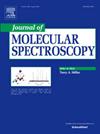Rotational spectroscopy of the benzofuran–water complex: Conformations and preferred noncovalent interactions
IF 1.3
4区 物理与天体物理
Q4 PHYSICS, ATOMIC, MOLECULAR & CHEMICAL
引用次数: 0
Abstract
We investigated the non-covalent interactions occurring between benzofuran and water. The weakly-bound complex was produced using a supersonic jet expansion and was subsequently characterized utilizing high-resolution Fourier transform microwave spectroscopy. Through the analysis of the rotational spectrum, we were able to confirm the detection of two distinct conformations within the complex. The most stable conformation demonstrates a structure that is almost coplanar. This structure involves one hydrogen atom from a water molecule interacting with the oxygen atom of benzofuran, thus forming an Ow–Hw···O hydrogen bond. Concurrently, the oxygen atom serves as a proton acceptor, forming an Ow···H![]() C hydrogen bond with one hydrogen atom of the phenyl ring. The secondary conformation positions the two O
C hydrogen bond with one hydrogen atom of the phenyl ring. The secondary conformation positions the two O![]() H bonds such that they are oriented towards the face of benzofuran, resulting in the formation of two Ow–Hw···π hydrogen bonds. The non-covalent bonding topology of the first conformation bears resemblance to the corresponding furan-water complex, while the second conformation aligns with the benzofuran-hydrogen sulfide complex. The strength and the nature of these hydrogen bonding interactions is delineated by the application of natural bond orbital theory, energy decomposition, and electronic density analysis methodologies.
H bonds such that they are oriented towards the face of benzofuran, resulting in the formation of two Ow–Hw···π hydrogen bonds. The non-covalent bonding topology of the first conformation bears resemblance to the corresponding furan-water complex, while the second conformation aligns with the benzofuran-hydrogen sulfide complex. The strength and the nature of these hydrogen bonding interactions is delineated by the application of natural bond orbital theory, energy decomposition, and electronic density analysis methodologies.

苯并呋喃-水络合物的旋转光谱:构象和优选的非共价相互作用
我们研究了苯并呋喃与水之间的非共价相互作用。弱结合配合物是利用超音速射流膨胀产生的,随后利用高分辨率傅里叶变换微波光谱进行了表征。通过对旋转光谱的分析,我们能够确认在配合物中检测到两种不同的构象。最稳定的构象显示出一种几乎共面的结构。这种结构是水分子中的一个氢原子与苯并呋喃的氧原子相互作用,从而形成一个低氢···O氢键。同时,氧原子作为质子受体,与苯基环的一个氢原子形成Ow···HC氢键。二级构象使两个氢键朝向苯并呋喃的表面,从而形成两个低氢···π氢键。第一种构象的非共价键拓扑结构与相应的呋喃-水配合物相似,而第二种构象与苯并呋喃-硫化氢配合物一致。这些氢键相互作用的强度和性质是通过应用自然键轨道理论、能量分解和电子密度分析方法来描述的。
本文章由计算机程序翻译,如有差异,请以英文原文为准。
求助全文
约1分钟内获得全文
求助全文
来源期刊
CiteScore
2.70
自引率
21.40%
发文量
94
审稿时长
29 days
期刊介绍:
The Journal of Molecular Spectroscopy presents experimental and theoretical articles on all subjects relevant to molecular spectroscopy and its modern applications. An international medium for the publication of some of the most significant research in the field, the Journal of Molecular Spectroscopy is an invaluable resource for astrophysicists, chemists, physicists, engineers, and others involved in molecular spectroscopy research and practice.

 求助内容:
求助内容: 应助结果提醒方式:
应助结果提醒方式:


